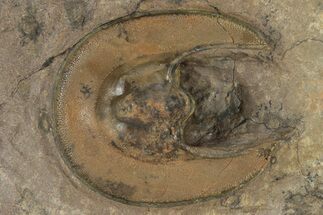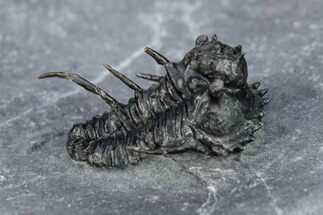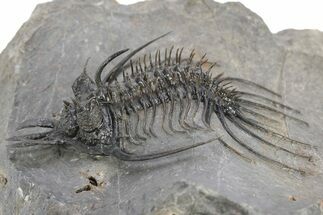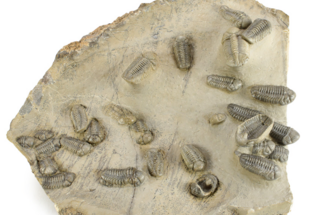This Specimen has been sold.
1.9" Harpid (Scotoharpes) Trilobite Fossil - Boudib, Morocco
Here is a gorgeous, 1.9" long, prone example of the Harpetid trilobite, Scotoharpes, collected from the Middle Devonian-aged El Otfal Formation in Morocco. It has a very dramatic "head shield" which is often interpreted as a mechanism to help it stay on top of a soft ocean floor. This preglabellar ring (head shield) is covered in many sensory pits which may have held hairlike features when the trilobite was alive.
The preparation is stunning and it is laid out prone while most of these harpids are curled. It has about 5% shell restoration in total along repaired cracks and most of the segments and pygidium appears to be a composite.
The preparation is stunning and it is laid out prone while most of these harpids are curled. It has about 5% shell restoration in total along repaired cracks and most of the segments and pygidium appears to be a composite.
About Trilobites
Trilobites were a very diverse group of extinct marine arthropods. They first appeared in the fossil record in the Early Cambrian (521 million years ago) and went extinct during the Permian mass extinction (250 million years ago). They were one of the most successful of the early animals on our planet: over 25,000 species have been described, filling nearly every evolutionary niche. Due in large part to their hard exoskeletons (shells), they left an excellent fossil record.
Trilobites were a very diverse group of extinct marine arthropods. They first appeared in the fossil record in the Early Cambrian (521 million years ago) and went extinct during the Permian mass extinction (250 million years ago). They were one of the most successful of the early animals on our planet: over 25,000 species have been described, filling nearly every evolutionary niche. Due in large part to their hard exoskeletons (shells), they left an excellent fossil record.
SPECIES
Scotoharpes sp.
AGE
LOCATION
Boudib, Morocco
FORMATION
El Otfal Formation
SIZE
1.9" long
CATEGORY
SUB CATEGORY
ITEM
#328637
We guarantee the authenticity of all of our specimens.
 Reviews
Reviews















